Below is a list of known recordings of Dinu Lipatti. This discography is currently in draft format and will be revised.
June 25, 1936
Ecole Normale de Musique, Paris
1. Bach: Partita No.1 in B-Flat Major, BWV 825: Prelude, Sarabande, Allemande*
2. Bach-Lipatti: Improvisation (on Bach-Busoni Toccata in C)*
3. Brahms: Intermezzo in B-Flat Minor, Op.117 No.2 (abbr.)
4. Enescu: Sonata in F-Sharp, Op.24 No.1: ii. Presto vivace
5. Brahms: Intermezzo in E-Flat minor, Op.118 No.6
*Bach works performed on harpsichord
February 20, 1937; March 12, 1937; January 22, 1938
Salle Gouin, Paris
6. Brahms: Liebeslieder Walzer Op.52
with Nadia Boulanger, piano, Irene Kedroff (soprano), Marie-Blanche de Polignac (alto), Hugues Cuenod (tenor), Paul Derenne (tenor), Doda Conrad (bass)
February 25, 1937
Paris
7. Brahms: Waltzes for Piano 4-hands, Op.39: Nos. 6, 15, 2, 1, 14, 10, 5, 6
with Nadia Boulanger, piano
ca.1940-1941
Bucharest
8. Mozart-Busoni: Duettino Concertante for 2 pianos
with Madelaine Lipatti, piano
This unpublished test recording unfortunately deteriorated to the point that it could not be salvaged
April 28, 1941
Bucharest Broadcasting Studio, Bucharest
9. Bach-Hess: Jesu, Joy of Man’s Desiring (abbr)
10. Brahms: Intermezzo in A Minor, Op.116 No.2
11. Brahms: Intermezzo in E-Flat Major, Op.117 No.1
12. Chopin: Waltz No.2 in A-Flat Major, Op.34 No.1
13: Chopin: Etude in G-Flat Major, Op.10 No.5
14: Liszt: Concert Etude No.2: Gnomenreigen
15: Scarlatti: Sonata in G, L387 (Kk14)
16: Schumann: Etudes Symphoniques Op.13: No.9
Note: Some of these recordings may not have been recorded at this session. They were found in a private collection and Lipatti’s biographers Dragos Tanasescu and Grigore Bargauanu believed them all to be made on this, but this has not been verified.
January 14, 1943
Berlin
17. Lipatti: Concertino in Classical Style, Op.3
Hans von Benda, Berlin Chamber Orchestra
March 2, 1943
Romanian Broadcasting Studio, Bucharest
18. Enescu: Suite for Piano No.2 in D, Op.10: Bourree
March 4, 1943
Romanian Broadcasting Studio, Bucharest
19. Lipatti: Sonatina for left hand
March 11, 1943
Romanian Broadcasting Studio, Bucharest
20. Enescu: Violin Sonata No.3 in A Minor, Op.25
with Georges Enescu, violin
March 13, 1943
Romanian Broadcasting Studio, Bucharest
21. Enescu: Violin Sonata No.2 in F Minor, Op.6
with Georges Enescu, violin
October 18, 1943
Radio Bern
22. Enescu: Piano Sonata No.3 in D Major, Op.24
February 20, 1947
EMI Abbey Road Studio No.3, London
23. Scarlatti: Sonata in D Minor, L413 (Kk9)
24. Chopin: Nocturne No.8 in D-Flat Major, Op.27 No.2
March 1 and 4, 1947
EMI Abbey Road Studio No.3, London
25. Chopin: Piano Sonata No.3 in B Minor, Op.58
May 24, 1947
Wolfbach Studio, Zurich
26. Beethoven: Cello Sonata No.3 in A Major, Op.69: I. Allegro ma non tanto
27. Bach: Cello Sonata in D: II. Andante
28. Chopin: Nocturne in C-Sharp Minor
29. Faure: Apres un reve
30. Rimsky-Korsakov: The flight of the bumblebee
31. Ravel: Piece en forme de habanera
with Antonio Janigro, cello
June 6, 1947
Grand Theatre, Geneva
32. Liszt: Piano Concerto No.1 in E-Flat Major
with Ernest Ansermet, Orchestre de la Suisse Romande
Note – At the same concert, Lipatti performed Chopin’s Andante Spianato and Polonaise, but that recording has not been found
September 18 and 19, 1947
EMI Abbey Road Studio No.1, London
33. Grieg: Piano Concerto in A Minor, Op.16
with Alceo Galliera, The Philharmonia Orchestra
September 24, 1947
EMI Abbey Road Studio No.3, London
34. Chopin: Waltz No.2 in A-Flat Major, Op.34 No.1
35. Bach-Hess: Jesu, Joy of Man’s Desiring
36. Liszt: Sonetto del Petrarca No.104
September 25, 1947
BBC Studios, London
37. Liszt: La Leggierezza
September 27, 1947
EMI Abbey Road Studio No.3, London
38. Scarlatti: Sonata in E Major, L.23 (Kk380)
October 2, 1947
Concertgebouw, Amsterdam
39. Bach-Busoni: Piano Concerto No.1 in D Minor, BWV 1052
with Eduard van Beinum, Amsterdam Concertgebouw Orchestra
April 9 and 10, 1948
EMI Abbey Road Studio No.1, London
40. Schumann: Piano Concerto in A Minor, Op.54
with Herbert von Karajan, The Philharmonia Orchestra
April 17, 1948
EMI Abbey Road Studio No.3, London
41. Ravel: Alborada del Gracioso
April 17 and 21, 1948
EMI Abbey Road Studio No.3, London
42. Chopin: Barcarolle in F-Sharp Major, Op.60
May 30, 1948
Studio Kurhaus, Grosser Buehnensaal, Baden-Baden
43. Bartok: Piano Concerto No.3
with Paul Sacher, Sinfonie-Orchester des Suedwestfunks
February 7, 1950
Tonhalle, Zurich
44. Chopin: Piano Concerto No.1 in E Minor, Op.11
with Otto Ackermann, Zurich Tonhalle-Orchester
45. Chopin: Nocturne No.8 in D-Flat Major, Op.27 No.2
46. Chopin: Etude No.17 in E Minor, Op.25 No.5
47. Chopin: Etude No.5 in G-Flat Major, Op.10 No.5
February 22, 1950
Victoria Hall, Geneva
48. Schumann: Piano Concerto in A Minor, Op.54
with Ernest Ansermet, Orchestre de la Suisse Romande
July 3-12, 1950
Studio 2, Radio Geneve
Chopin: Fourteen Waltzes
49. No.4 in F Major, Op.34 No.3 (July 9)
50. No.5 in A-Flat Major, Op.42 (July 11)
51. No.6 in D-Flat Major, Op.64 No.1 (July 6)
52. No.9 in A-Flat Major, Op.69 No.1 (July 3)
53. No.7 in C-Sharp Minor, Op.64 No.2 (July 3)
54. No.11 in G-Flat Major, Op.70 No.1 (July 3)
55. No.10 in B Minor, Op.69 No.2 (July 4)
56. No.14 in E Minor, Op. posth (July 12)
57. No.3 in A Minor, Op.34 No.2 (July 4)
58. No.8 in A-Flat Major, Op.64 No.3 (July 6)
59. No.12 in F Minor, Op.70 No.2 (July 5 and 9)
60. No.13 in D-Flat Major, Op.70 No.3 (July 9)
61. No.1 in E-Flat Major, Op.18 (July 9)
62. No.2 in A-Flat Major, Op.34 No.1 (July 8 )
July 6, 1950
Studio 2, Radio Geneve
63. Bach-Kempff: Siciliano
July 9, 1950
Studio 2, Radio Geneve
64. Bach: Partita No.1 in B-Flat Major, BWV 825
65. Mozart: Piano Sonata No.8 in A Minor, K 310
July 10, 1950
Studio 2, Radio Geneve
66. Bach-Busoni: Chorale Prelude, “Nun komm’, der Heiden Heiland”
67: Bach-Busoni: Chorale Prelude, “Ich ruf’ zu dir, Herr Jesu Christ”
68. Bach-Hess: Jesu, Joy of Man’s Desiring
July 11, 1950
Studio 2, Radio Geneve
69. Chopin: Mazurka No.32 in C-Sharp Minor, Op.50 No.3
July 27, 1950
Radio Geneve, Geneva
70. Interview with Francois Magnenat
71. Chopin: Waltz No.3 in A Minor, Op.34 No.2
72. Bach-Hess: Jesu, Joy of Man’s Desiring (excerpt)
73. Bach-Busoni: “Ich ruf’ zu dir, Herr Jesu Christ”
August 23, 1950
Kunsthaus, Lucerne
74. Interview with Henri Jaton
75. Mozart: Piano Concerto No.21 in C Major, K.467
with Herbert von Karajan, Orchester der Festspiele Luzern
September 16, 1950
Salle du Parlement, Besancon
76. Bach: Partita No.1 in B-Flat Major, BWV 825
77. Mozart: Piano Sonata No.8 in A Minor, K 310
78. Schubert: Impromptu No.3 in G-Flat Major, D.899 No.3
79. Schubert: Impromptu No.2 in E-Flat Major, D.899 No.2
Chopin: 13 Waltzes
80. No.5 in A-Flat Major, Op.42
81. No.6 in D-Flat Major, Op.64 No.1
82. No.9 in A-Flat Major, Op.69 No.1
83. No.7 in C-Sharp Minor, Op.64 No.2
84. No.11 in G-Flat Major, Op.70 No.1
85. No.10 in B Minor, Op.69 No.2
86. No.14 in E Minor, Op.posth
87. No.3 in A Minor, Op.34 No.2
88. No.4 in F Major, Op.34 No.3
89. No.12 in F Minor, Op.70 No.2
90. No.13 in D-Flat Major, Op.70 No.3
91. No.8 in A-Flat Major, Op.64 No.3
92. No.1 in E-Flat Major, Op.18
September 29, 1950
Radio Geneve, Geneva
93. Interview with Franz Walter
Note: The performance that Lipatti gave after the interview of the Bach-Kempff ‘Siciliano’ has not been located



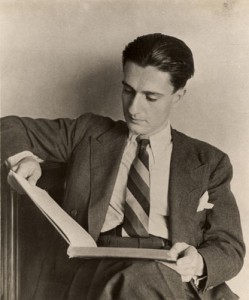
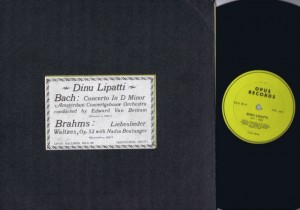
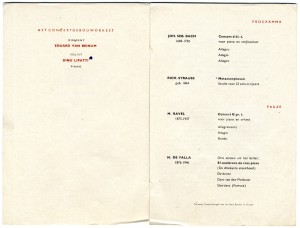
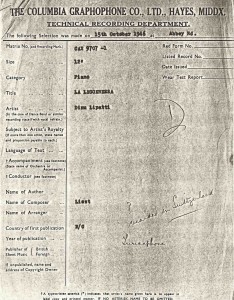
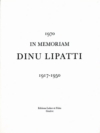
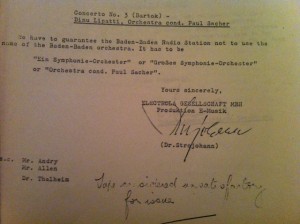
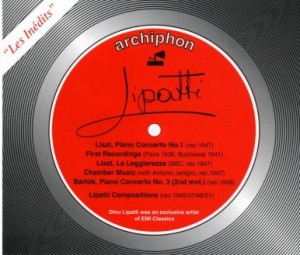
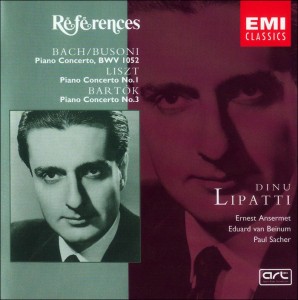
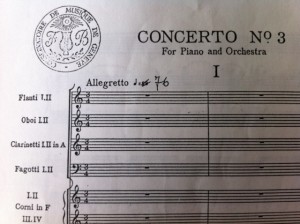
Recent Comments